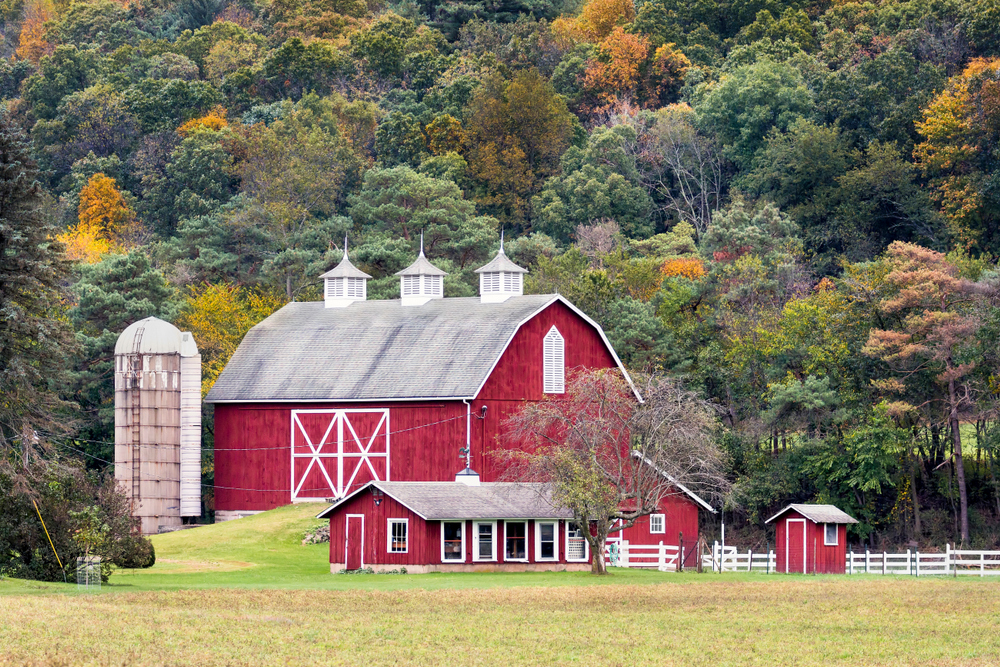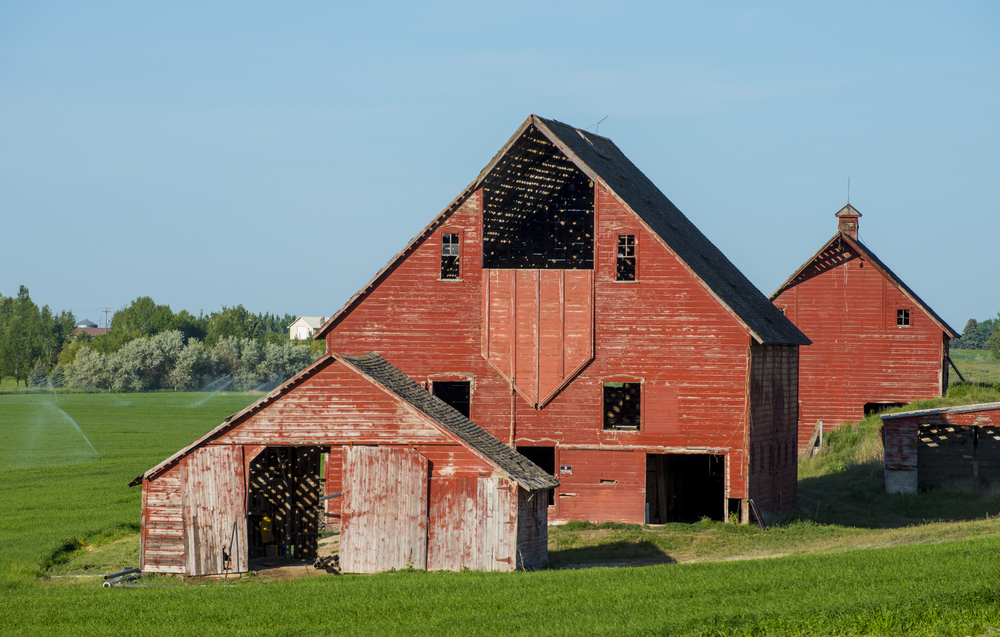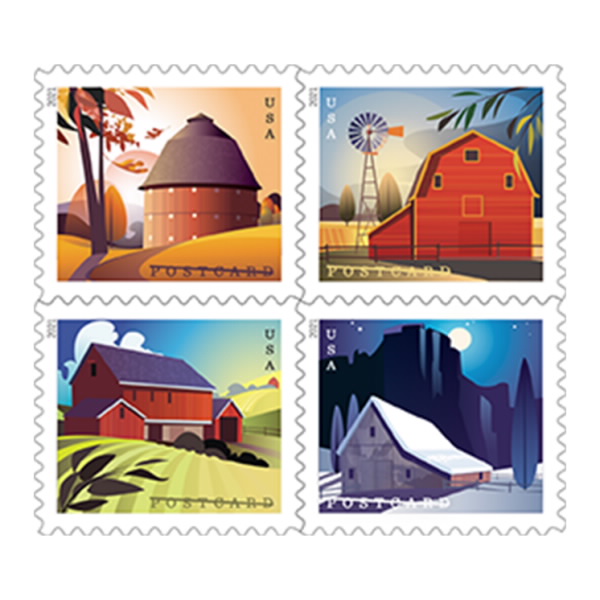Why Are Barns Painted Red?
It’s aesthetically pleasing, yes, but there’s a historic reason behind the crimson hue.
Why Are Barns Painted Red?
It’s aesthetically pleasing, yes, but there’s a historic reason behind the crimson hue.

A beautiful, big red barn.by Kenneth Keifer, Shutterstock.
This article is republished from The Conversation under a Creative Commons license. Read the original article.
There are three reasons we see so many red American barns. It’s traditional, it’s practical and the color looks good.
Although a main reason to paint wooden buildings is for appearances, paint also protects the wood so it lasts longer.
During the 1700s and early 1800s, barns on family farms in the Northeast were typically covered with thick vertical boards. When they were left unpainted, the boards would slowly weather to a brownish-gray color.
But after the mid-1800s, to improve the efficiency of their barns by reducing drafts to help keep their animals more comfortable in winter, many farmers tightened up their barns by having wooden clapboards horizontally nailed on the outside barn walls. These clapboards were sawed quite thin, so painting them provided needed protection and dressed up the appearance of the barns.

In the 1800s it was common for people to make their own paints by mixing pigments with linseed oil made from flax seeds and other ingredients. Pigments are dry materials that add color. They were available in various hues, but the tint we see so often on older American barns was called Venetian red.
According to the 1884 edition of Everybody’s Paint Book, by F.B. Gardner, Venetian red was “suitable for any common work, or for brickwork and outbuildings.” This red pigment penetrated well into wooden barn boards and resisted fading when exposed to sunlight, so it could age gracefully for generations.
Venetian red got its name because historically this pigment was produced from natural clays found near Venice, Italy. The clays contained an iron oxide compound that produced this red color.
But as people found similar iron oxide deposits in many other places, “Venetian red” became a generic term for light red pigments that did not have any purplish tinge. By the 1920s, such “earth pigments” used to make red paints were being dug in Georgia, Pennsylvania, Virginia, Alabama, California, Iowa and Vermont.
By the late 1800s, in addition to red, it became fashionable to paint barns with other color schemes, especially those designed to complement the architectural styles and finishes of owners’ houses. These included various hues of yellows, greens and browns. Also, white paint commonly was applied to barns and houses.
But red paint remained popular on many farms because it was the most affordable. In 1922 the Sears, Roebuck catalogue offered red barn paint for just $1.43 per gallon, while other colors of house paints sold for at least $2.25 per gallon—nearly twice as much.

Today, many modern barns don’t resemble classic versions. Very large barns that hold hundreds of cows or pigs look more like hangars or warehouses, and may be built of metal. But the tradition of painting smaller barns red continues—so strongly that the US Postal Service now celebrates them on postage stamps.
Thomas D. Visser, Professor of Historic Preservation, is the director of the graduate Historic Preservation Program in the Department of History at the University of Vermont.
Follow us
This work is licensed under a Creative Commons Attribution-NoDerivatives 4.0 International License.
Want to republish a Modern Farmer story?
We are happy for Modern Farmer stories to be shared, and encourage you to republish our articles for your audience. When doing so, we ask that you follow these guidelines:
Please credit us and our writers
For the author byline, please use “Author Name, Modern Farmer.” At the top of our stories, if on the web, please include this text and link: “This story was originally published by Modern Farmer.”
Please make sure to include a link back to either our home page or the article URL.
At the bottom of the story, please include the following text:
“Modern Farmer is a nonprofit initiative dedicated to raising awareness and catalyzing action at the intersection of food, agriculture, and society. Read more at <link>Modern Farmer</link>.”
Use our widget
We’d like to be able to track our stories, so we ask that if you republish our content, you do so using our widget (located on the left hand side of the article). The HTML code has a built-in tracker that tells us the data and domain where the story was published, as well as view counts.
Check the image requirements
It’s your responsibility to confirm you're licensed to republish images in our articles. Some images, such as those from commercial providers, don't allow their images to be republished without permission or payment. Copyright terms are generally listed in the image caption and attribution. You are welcome to omit our images or substitute with your own. Charts and interactive graphics follow the same rules.
Don’t change too much. Or, ask us first.
Articles must be republished in their entirety. It’s okay to change references to time (“today” to “yesterday”) or location (“Iowa City, IA” to “here”). But please keep everything else the same.
If you feel strongly that a more material edit needs to be made, get in touch with us at [email protected]. We’re happy to discuss it with the original author, but we must have prior approval for changes before publication.
Special cases
Extracts. You may run the first few lines or paragraphs of the article and then say: “Read the full article at Modern Farmer” with a link back to the original article.
Quotes. You may quote authors provided you include a link back to the article URL.
Translations. These require writer approval. To inquire about translation of a Modern Farmer article, contact us at [email protected]
Signed consent / copyright release forms. These are not required, provided you are following these guidelines.
Print. Articles can be republished in print under these same rules, with the exception that you do not need to include the links.
Tag us
When sharing the story on social media, please tag us using the following: - Twitter (@ModFarm) - Facebook (@ModernFarmerMedia) - Instagram (@modfarm)
Use our content respectfully
Modern Farmer is a nonprofit and as such we share our content for free and in good faith in order to reach new audiences. Respectfully,
No selling ads against our stories. It’s okay to put our stories on pages with ads.
Don’t republish our material wholesale, or automatically; you need to select stories to be republished individually.
You have no rights to sell, license, syndicate, or otherwise represent yourself as the authorized owner of our material to any third parties. This means that you cannot actively publish or submit our work for syndication to third party platforms or apps like Apple News or Google News. We understand that publishers cannot fully control when certain third parties automatically summarize or crawl content from publishers’ own sites.
Keep in touch
We want to hear from you if you love Modern Farmer content, have a collaboration idea, or anything else to share. As a nonprofit outlet, we work in service of our community and are always open to comments, feedback, and ideas. Contact us at [email protected].by Thomas Durant Visser, Modern Farmer
November 30, 2021
Modern Farmer Weekly
Solutions Hub
Innovations, ideas and inspiration. Actionable solutions for a resilient food system.
ExploreExplore other topics
Share With Us
We want to hear from Modern Farmer readers who have thoughtful commentary, actionable solutions, or helpful ideas to share.
SubmitNecessary cookies are absolutely essential for the website to function properly. This category only includes cookies that ensures basic functionalities and security features of the website. These cookies do not store any personal information.
Any cookies that may not be particularly necessary for the website to function and are used specifically to collect user personal data via analytics, ads, other embedded contents are termed as non-necessary cookies.
Hey I m from a family of farmers
There is a church near me that was built in the early 1800s that has the three sides visible from the road painted white and the rear of the church not visible from the road is painted barn red.
This is such an interesting topic that many people don’t know about. I really enjoyed reading this article because it gave me more insight into how barns got their color and what was actually used to paint them in the first place.
Another reason red is popular over white for use in barns is the fact that in the early days if you painted your barn white you ran the risk of poisoning your livestock because early white paint contained lots of poisonous lead powder.
I’m Wisconsin…Completely ❄ America’s Dairyland ✌
Where were the red earth pigments dug in Vermont?
In Scandinavia, wooden houses have been painted red since 17 th century. It would be strange if that hasn’t influenced the red paint tradition in those parts of US where the establishment of farming had a large scandinavian origin.
The historical significance behind the iconic red barns in America is truly fascinating. The transition from weathered, unpainted barns to the widespread use of red paint during the 1800s, particularly with the introduction of wooden clapboards, not only served practical purposes but also contributed to the enduring aesthetic appeal of these structures.